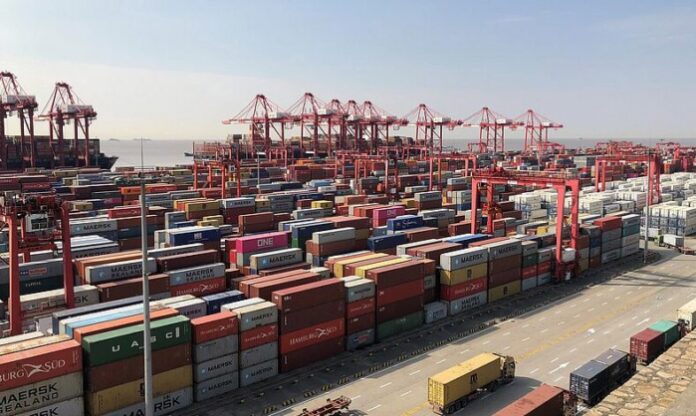
-
Cargo volumes and freight rates from China to the US are at their worst in 13 years as pre-Lunar New Year peak is missing, says BIMCO analyst
-
Spot and average rates for containers loading in Shanghai are still sliding, unlike in previous years when rates were normally 12% higher less than 10 weeks before the holiday
-
Asia-US container rates are steady or gain slightly while Asia-Northern Europe rates gain 14% on Freightos’ index and Drewry says Shanghai rates to Rotterdam rise 10% and to Genoa gain 2%
Pre-Lunar New Year cargo volumes and freight rates from China to the US are at their worst in 13 years as the traditional spike in the lead-up to the country’s biggest holiday is missing this year, partly due to its COVID crisis and a demand slump in the US, analysts said.
With the holiday less than three weeks away, spot and average rates for containers loading in Shanghai are continuing to fall, in contrast to previous years when rates were normally 12% higher in China’s premier port less than 10 weeks earlier, said Niels Rasmussen, chief shipping analyst at BIMCO.
He said the average rate for all containers shipped out of China normally ended 4% up in this period. He based his assumptions on the China Containerized Freight Index, which has fallen 50% since February 2022 and was at 1,730 seven weeks ago, slid to 1,271 last week, lost a further 27% since mid-November.
RELATED READ: Pre-CNY cargo rush to push ex-Asia rates higher
“From 2011 to 2020, the CCFI on average increased 3% in the seven weeks from week 10 before CNY (Chinese New Year) to week 3 before CNY. The worst year was 2012 when the CCFI fell 6% during those seven weeks while the best year was 2020 with an 8% increase,” Rasmussen said in a BIMCO report.
“The market situation in 2021 and 2022 was unique as congestion and a spike in consumer demand led the market, and the lead-up to CNY was also strong. So far, the development in 2023 is therefore the worst in 13 years.”
The CCFI is showing a worse than normal development in all trade lanes. To Europe and Mediterranean, the index has fallen by respectively 34% and 57% during the last seven weeks whereas the index for exports to the US West Coast and East Coast are down by 26% and 27% respectively.
Freightos head of research Judah Levine said workers calling in sick after China’s easing of COVID restrictions are causing a labor shortage in Chinese port, resulting in shipping delays that combine with a dull market for some US logistics providers, contributing to the rate slide.
“The extent and duration of China’s COVID surge will determine how disruptive it will prove to manufacturing and international trade. In the meantime though, as demand for freight continues to decrease, some additional congestion may not be felt very widely,” said Levine.
He said new US economic data show consumer spending on goods slowing. “This pullback, alongside inventory recoveries for many retailers, is causing pain for some logistics providers like FedEx,” he said.
But Levine said easing supply chain disruptions – including falling freight rates and more stable inventory levels as congestion eases and delays decrease – is one factor that has returned negotiating power to big retailers and could result in lower consumer prices.
Shipping rates from Asia to the US this past week were mixed, with the Drewry World Composite Index advancing 0.7%, the first increase in 43 weeks, and the Freightos Baltic Index staying unchanged.
Post-New Year rates from Asia to Northern Europe rallied, with Freightos saying Asia-Northern Europe prices (FBX11 Weekly) rose 14% to $2,741 per 40-foot box, 81% lower than the same week last year. Drewry reported 10% and 2% rate gains on the Shanghai to Rotterdam and Genoa routes.
The latest Drewry WCI Asia-US rates is US$2,135 per 40-foot container, 77% down from a year ago, Drewry Supply Chain Advisors said. The year-to-date average composite index is $2,135, lower by $559 than the 10-year average.
The index is 79% below its $10,377 peak in September 2021 and 21% off the 10-year average of $2,694, indicating a return to more normal levels. It’s still 50% above the pre-pandemic average rate of $1,420.
Freightos’ Asia-US West Coast rate this past week was $1,382/FEU, down 89% from a year ago. This compares with Asia-US East Coast rates falling 1% to $2,898/FEU, 82% lower than last year.
RELATED READ: Long-term container rates track spot market dip
Drewry rates on Shanghai-Rotterdam gained 10% or $168 to $1,874/FEU. Spot rates on Shanghai-Genoa rose 2% or $47 to $2,926. Rates on Rotterdam-New York fell 6% or $400 to $6,589/FEU.
Rates on Los Angeles-Shanghai and Shanghai-New York fell 3% each to $1,138 and $3,788/FEU, respectively, while those on New York-Rotterdam slid 2% to $1,243/FEU.
Similarly, Rotterdam-Shanghai and Shanghai-Los Angeles eased 1% each to $785 and $1,964/FEU.




